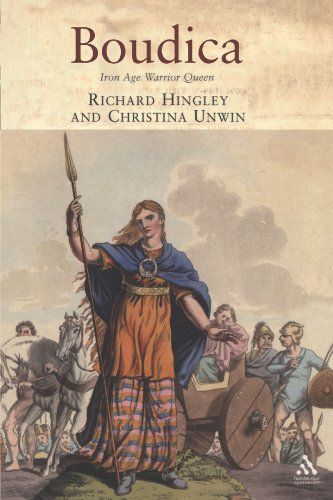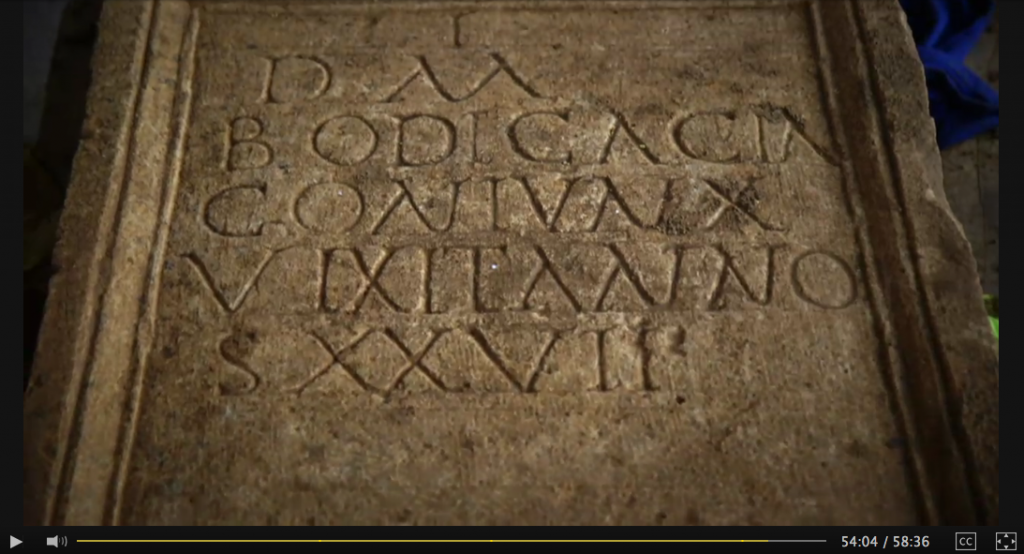
Last night I was engrossed in watching the final episode on the BBC historical documentary The Celts but was taken aback when just after taking us through the story of Boudicca’s revolt against Rome I was hit with the following dialogue of the program’s two narrators:
The Celts
(Season 1 Episode 3)
location: 52:45 to 54:35
Professor Alice Roberts: The defeat was total. Boudicca’s entire army was wiped out. According to Tacitus only 400 Romans were killed that day compared with 80,000 Celts. The last great Celtic rebellion was over.
Neil Oliver: We’re told Boudicca survived the battle but poisoned herself shortly after, and with her died any hope of another Celtic uprising and an end to Roman rule in Britannia.
Alice Roberts: Boudicca disappeared from history and entered into national mythology, a martyr to the idea of a free Britain. But while the Celtic rebellion was certainly real can we be absolutely sure that Boudicca played a part in it or even existed? No archaeological evidence of Boudicca herself has been found.
Neil Oliver: Then, in the Spring of 2015, in Gloucestershire, an ancient gravesite was discovered dating to the Roman occupation of Britain. In amongst the human remains was a gravestone and on it was carved the name Bodicacia. Underneath the stone lay a skeleton. Could this finally be evidence of Britain’s great warrior queen? But the bones belonged to a man. And the myth of Boudicca continues to this day.
Ever since my middle years of primary school when we were taught of the famous feats of “Boadicea” [the Latinized form of her name] and her chariots it has never occurred to me to question the historical existence of Boudicca (Boudica) [the current “correct” forms representing her name].
So this morning I tracked down Alice Roberts’ book The Celts to see if she has given us names of historians who have raised the question of Boudicca’ historicity. My interest (you may have guessed) is in the methods used by historians either side of the question to see if they can throw any light on the discussion of prominent biblical characters, such as, say, to take one at random, Jesus. No luck. But AR did express her own positive opinion with respect to Boudicca’s existence:
. . . . As for Boudica herself, the historians are remarkably inconsistent. We are told that the revolt melted away; that Boudica fell ill and died; that she poisoned herself. In the end, we simply can’t be sure of the fate of the last warrior queen of the Celts. . . .
. . . .
But what about individual characters? Again, how far can we trust the classical accounts? Some authors have even suggested that Boudica – this vision of a powerful woman who threatened Caesar – was a Roman invention, a bit of propaganda. But most scholars accept that she did exist. ‘I believe she was real,’ Barry Cunliffe told me. ‘It just wasn’t the sort of thing the Romans did – to invent characters. It doesn’t fit at all with what we know about Roman historical writing.’ And the Romans probably found her a surprising character. They were used to powerful women – the wives and mothers of the emperors held great power – but the potential for a woman to become a war leader represented a stark difference between Celtic and Roman society. Boudica wasn’t the only warrior queen that the Romans would have been aware of. In the north of Britain, in the mid-first century BC, Queen Cartimandua led a confederation of Celtic tribes which were loyal to Rome – until she was ousted by her ex-husband, Venutius. This ambivalence towards gender, providing the possibility for women to become leaders of men and to achieve the highest status in Celtic society, also seems to be reflected in the chariot burials of Yorkshire: women as well as men were treated to such elite funerary rites. So there seems no reason to doubt the existence of a powerful female Celtic hero. Boudica may have been embellished, with various attributes added to her, but this tends to be the case for any war leader – the stories of Che Guevara walking on water providing a more recent example. The picture we get is a ‘constructed Boudica’, but the nucleus is real.
“No reason to doubt”. Hoo boy! Where have we heard that line before. But I can forgive Alice Roberts because she is not a historian and is here deferring to a historian’s opinion. Unfortunately she leaves no trace in the book based on the TV series of those historians who have apparently questioned the historical reality of Boudicca. So I cast the Google net wider. Most sites assumed her historicity; some sites emphatically stated that she did exist and any suggestion otherwise was essentially daft. No-one (scholars, even) questioned her existence, one site said.
A key reason, surely a very strong one, for “not doubting” the Roman accounts is that the first historian to leave us a record, Tacitus, was a young boy at the time of Boudicca’s rebellion; but more significantly, his father-in-law was a governor in Britannia after the rebellion was crushed so would have had knowledge of the events and have been able to inform Tacitus
But I kept looking and found a few that were more open to the question such as:
- The Greenman site: Boudicca Questions
- A “Grand Medieval Historian” on a discussion forum (this post includes extensive bibliographical references that might be worth following up)
And another, Military History Online, that concluded on a somewhat uncertain note.

But eventually I found one work by an archaeologist, Miranda Aldhouse-Green, that was prepared to question Boudicca in history in Boudica Britannia : rebel, war-leader and queen. Early in the book Aldhouse-Green writes:
Boudica (or Boadicea) is well known today, but the lack of hard evidence for her existence and legendary struggle against Rome is astonishing. For historical accounts of Boudica, we are reliant on brief passages from the ancient authors Tacitus and Cassius Dio, neither of whom were contemporaries of the Boudican Rebellion. Each of these historians wrote entirely from a Roman perspective and both had a ‘spin’ on the episode – an agenda or interpretative prism through which they were seeking to present their account.
Aldhouse-Green concedes the plausibility of Boudicca’s place in history given what we know of Celtic civilization and the place it allowed for women. Her difficulty lies with the nature of the Roman historians (Tacitus and Cassius Dio) who wrote about Boudicca. Their respective agendas and known rhetorical creativity make it impossible for us to disentangle genuine fact from their own biases and imaginations. Here is one passage outlining some of the difficulties a reader of Cassius Dio must take on:
One of his favourite genres within the Roman History is what Fergus Millar has termed ‘tragic history’: accounts of human disasters, such as earthquakes and massacres, in order to play on the emotional impact on his audience of these events. 40 His account of the Boudican Rebellion and, in particular, of the atrocities committed by Boudica in cities like London, 41 fall neatly into this category. We ought also to take into account the elements of fiction that form portions of Dio’s work, and we can assume that he would have been unable to resist embellishing the drama of episodes like the Boudican campaign.
As in the case of Tacitus, then, we must read Dio with caution and with an understanding of the background and context that caused him to compose his particular brand of historical record. We should not assume that his physical description of the British war-leader owes any more to fact than to literary licence. His creation of a huge, manlike woman, with arresting features and bright hair – all physical characteristics completely alien to those Mediterranean women of whom Dio would have had most experience – may be entirely or partially fictitious, but it certainly adds to the storyline. Dio’s Boudica is strange, outlandish and barbaric (like Britain itself); her gender is ambiguous and her clothing and adornments are all stereotypic topoi of ‘otherness’.
Aldhouse-Green, Miranda. Boudica Britannia (pp. 131-132)
There’s another detail that surely deserves to give some pause: the name Boudicca itself is derived from the Celtic word for Victory.
Both Tacitus and Dio call the Icenian freedom fighter by the name of Boudica or Boudouica, a title or epithet deriving from a Celtic word ‘bouda’, meaning ‘victory’. She only appears in the literature in the context of conflict, so we have no means of knowing whether this was the name she was born with or whether it was an honorific title bestowed upon her by her followers or adopted by the woman herself as a propaganda exercise. But Boudica seems to have identified herself with victory: it was to the goddess of this virtue to whom she prayed at the sacred grove in London, after committing unspeakable acts of bestiality towards Roman Londoners. Dio tells us that she conducted sacrificial rites and orgiastic feasting ‘in the grove of Andate… the name they gave to Victory’. In this way, Boudica the woman identified herself with the invincibility of Victory the goddess, and thus presented herself to Britons and Romans alike as being above mere humanity, in the same way as she is depicted as beyond gender. There is, moreover, a subtle irony here in the differing treatments of British and Roman ‘victory’. While Boudica (‘ the victorious one’) and Andraste, goddess of victory were, for the present, in the ascendant, in the run-up to the rebellion the Roman statue of Victory at Colchester apparently fell with ‘its back turned as though it were fleeing the enemy’. This proved to be a sinister omen of what was to befall the Romans at Boudica’s hands.
(p. 132)
There are many more arguments set out by Aldhouse-Green that give us reason to wonder about Boudicca’s existence, even though Aldhouse-Green does not particularly embrace all of them herself. She informs us, for example, that some historians doubt that the worst atrocities of the Celts actually took place at all because their extreme portrayal sounds too much like dramatic moralistic tales of woe being inflicted on a corrupt and deserving Rome so that they smack of conveniently manufactured moralistic and entertaining tales.
We must also ask, we are reminded, how our historians actually knew the details they write about. Yes, Tacitus’s father was a governor in Britannia but how would he know such details as the specific reasons for their uprising? How likely was it that such a person communicated so well with disaffected subjects?

Oh yes — one more thing I almost forgot. There is no record in Britain of Boudicca until the time of the Renaissance. Earlier “histories” did know of the attempt to drive out the Romans in the time of Nero but leave no hint that they had ever heard of the famous queen.
And neither Tacitus nor Cassius Dio name their sources of information.
Let me emphasize that Miranda Aldhouse-Green is not denying the historical existence of Boudicca. She is advancing reasons for us to be cautious, to acknowledge that there is room for doubt. We need to acknowledge the methods of Roman historians and their agendas. We also need to acknowledge that Tacitus, born 56 CE, could scarcely be called a contemporary to the Celtic rebellion against Rome in ca 61-62 CE.
Back in 2013 I set out a table to draw attention to the sorts of evidence we have for the existence of ancient persons compared with others over whom rests some doubt. I am curious to see how Boudicca fits in that chart so let’s add her now:
Historical name
(Green – primary evidence exists so historicity certain) |
Name appears in non-fiction literature confirmed by primary evidence | Name appears in non-fiction literature confirmed by independent literary sources | Verifiable and credible author / provenance of non-fiction literature.
Thus can be reasonably confident the author’s sources are likely traced to time of the person/events. |
Genre supports historicity |
|---|---|---|---|---|
| Alexander the Great
(established by archaeological evidence) |
Yes (e.g. Arrian — compare coins and epigraphic evidence) | Yes (e.g. Diodorus Siculus, Plutarch, Curtius, Plutarch, Pompey Trogus/Jerome) | Yes (see Comparing Sources for Alexander and Jesus) | Yes |
| Julius Caesar
(established by archaeological evidence) |
Yes (e.g. Caesar — coins, fort . . .) |
Yes (e.g. Appian, Cassius Dio, Plutarch, Suetonius) |
Yes (see Appian, Suetonius . . . ) | Yes |
| Pilate
(established by archaeological evidence) |
Yes (e.g. Josephus — inscription) | Yes — Tacitus, Philo) | Yes (see Josephus et al) | Yes |
| Publius Vinicius the Stammerer | Yes (e.g. Seneca — Nero and coins) | Yes — (Tacitus, Cassius Dio) | Yes (Seneca — see Evidence) | Yes |
| Honi the Circle Drawer | Yes (Josephus — archaeological artefacts) | Yes | ||
| Bernice (daughter of Herod Agrippa I) | Yes (Josephus — archaeological artefacts) | Yes — (Tacitus, Cassius Dio . . .) | Yes (Josephus) | Yes |
| Tiro (Cicero’s slave) | Yes (e.g. Cicero — archaeological artefacts) | Yes — (Plutarch . . . ) | Yes (Cicero) | Yes |
| Socrates | Yes (e.g. Aristophane — archaeological artefacts) | Yes — (Plato, Xenophon ) | Yes (Xenophon. . .) | ? |
| Hillel | ? | ? | ? | ? |
| Hercules | Yes | Yes | No | No |
| Romulus | Yes | Yes | No | No |
| Jesus | ? | ? | No | No |
| Boudicca | Yes (Tacitus and Cassius Dio — archaeological evidence for the revolt) | Yes-but — Cassius Dio often contradicts Tacitus; using an independent source or writing with different agenda?) | ? — Aldhouse-Green gives reasons to question the view that Tacitus’s sources are first-hand witnesses | Yes (but history genre of ancients also includes practices of literary fictions) |
Ouch. Now I review that chart and I see it was too simplistic anyway. Notice that I have added to “buts” to two of the “yes” responses to the evidence for Boudicca. I guess that means I’m becoming less black and white in my thinking over time. Socrates also deserves a “Yes-but” where Plato and Xenophon were named together since they each have often contradictory portraits of Socrates.
If you enjoyed this post, please consider donating to Vridar. Thanks!

On the other hand no one attributes any supernatural aspects to Boudicca or her life and since there was a rebellion there must have been someone to lead it.
Still more believable than Jesus.
If we had the witness by a “Josephus” from Britannia who was entirely silent about this queen, then the Argument from Silence against Boudicca’s historicity would be strong just as the Argument from Silence against the historical Jesus is strong (given what the epistles say about him).
Well there’s no mention of her in the Arthurian literature so…
Interestingly the Roman historians did attribute a series of supernatural portents to the rise of Boudicca; she was also found to be a fulfillment of divine prophecies; and she herself was drawn as a supra-human, a woman more male than female, wild and alien to any normal society.
I always enjoy this kind of post. Thanks.
I don’t know the age of the sceleton, but if the age fits, our identification of it as ‘male’ need not mean it can’t be Boudica.
could the ‘impulsore Chresto’ be a suetonian invention?